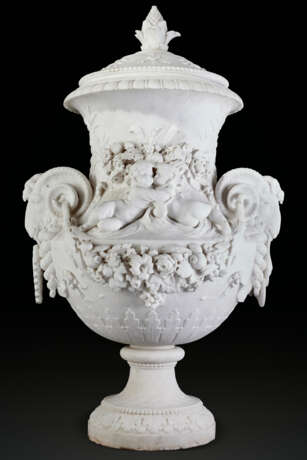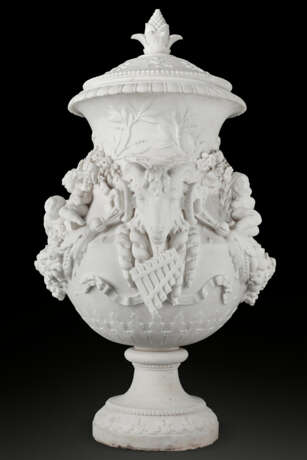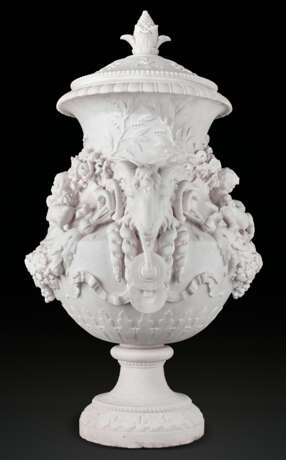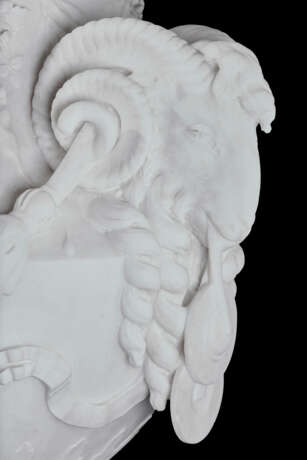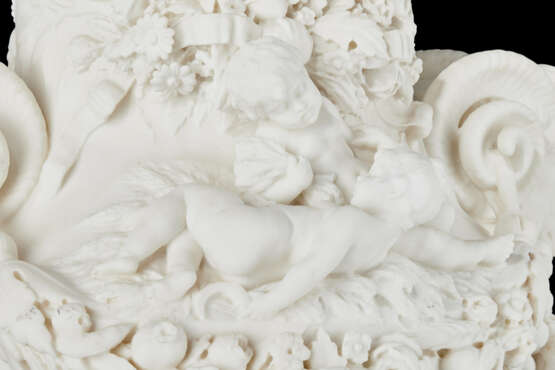ID 1329897
Los 25 | CHARLES ADRIEN PROSPER D'ÉPINAY (1836-1914)
Schätzwert
€ 80 000 – 120 000
Vase monumental dit "vase du duc de Gramont"
marbre, le couvercle et le corps d'une seule pièce, le corps à décor des allégories de l'été et de l'hiver, anses à décor de têtes de bélier, reposant sur un piédouche
H. 115 cm (45 ¼ in.) ; L. 72 cm (28 1/3 in.)
Literature
BIBLIOGRAPHIE COMPARATIVE
C. Vento, Les Peintres de la Femme, Paris, 1888.
L. L'Homme, Le statuaire Prosper d'Epinay, 1890, Île Maurice, 1890, p. 34.
P. Roux-Foujols, Prosper d'Épinay, un sculpteur mauricien à la cour des princes, Île Maurice, 1996.
A. Blühm et al., The color of Sculpture 1840-1910, cat. exp. 26 juillet - 17 novembre 1996 et 13 démcbre 1996 - 6 avril 1997, Amsterdam-Leeds, 1996- 1997, p. 124.
J.L. Champion, C. Janoray, Antiquity revisited. The classique tradition in sculpture from Houdon to Guillaume, cat. expo. 12 octobre - 15 novembre 2000, New-York, 2000, p. 58-59, cat. 19.
Further details
A MONUMENTAL MARBLE VASE REPRESENTING THE ALLEGORICAL FIGURES OF SUMMER AND WINTER, CHARLES ADRIEN PROSPER D'ÉPINAY
Born in Mauritius in 1836 to an aristocratic family, Prosper d'Epinay was the student of Jean-Pierre Dantan, a Parisian caricaturist known as Dantan le Jeune. In 1861, the sculptor continued his studies in Rome, where three years later he founded his studio, active until 1912, at 57 Via Sistina. In France, he exhibited at the Salon des Artistes Français between 1874 and 1902 and at the Universal Exhibitions of 1867 and 1878. He also exhibited, in London, at the Royal Academy exhibitions between 1865 and 1881. Thanks to his ambition, his talent and his social standing, he enjoyed great success. He was part of Parisian high society, in particular the Cercle de la rue Royale, a Parisian club created at the beginning of the Second Empire. He was called the “sculptor to sovereigns” by his clientele, composed of many celebrities, aristocrats and monarchs. The French poet, Albert Mérat, evokes his success through the following quatrain :
“Monsieur d'Epinay fait la sucrerie
Comme Siraudin, le bon confiseur;
Et cela se vend et cela se crie
Chez le commissaire appelé priseur”
Albert Mérat, Le Petit Salon, 1876.
Both his commissions and his personal creations reflected the tastes of the late 19th century and his clients’ expectations. In the 1880s, furnishings became an important part of his work. Inspired by the decorative traditions of the Renaissance, the 17th century and the 18th century, d’Epinay satisfied collector’s eclectic tastes.
During this period, he created seven models. All correspond to the classicist tastes of this period : they are monumental, their handles are ornamented and they feature two scenes placed on either side of the vase in medallions or in fort-reliefs. Different media were used : the “Dauphin” (private collection) and the “Chasse aux Ours” (private collection) vases are in plaster, the “Rothschild” vase (unlocated) is in marble and the “Bacchus” vase is in bronze (before in the Schneider’s collection in Creuzot, today unlocated).
Only three models exist both in plaster and in marble. The marbles are in the Orsay Museum - “Renaissance Vase” (inv. ChM 147) and “Sappho Vase” (inv. ChM 142) -. Considering those elements, original plaster versions are the projects for marble versions. Prosper d'Epinay offered to the Duc de Gallese, a Roman patron and one of his friends, many plaster casts including the “Dolphins Vase”, the “Gramont Vase”, the “Sapho Vase” and the “Bears Hunting Vase”. Initially created for the museum dedicated to him, those works were in his studio when it closed.
The “Duc de Gramont vase”, as it is called, figures among the models in marble and in plaster that still exist today. While
a copy in plaster, signed by the artist and listed by his biographers, reappeared on the market a few years ago, the present finished marble version is a real discovery. No sources mention either the making or the delivery of the final vase ; not even J.L. Champion and C. Janoray in the catalog for the exhibition Antiquity revisited. The Classical tradition in Sculpture from Houdon to Guillaume still questioned its material. After his second wedding, to Marguerite de Rothschild, Agénor de Gramont (1851-1925) built and moved into Château de Vallière in Mortefontaine in 1894. During this period, the Duke would have commissioned the vase from Prosper d'Épinay, probably for his new home. Its allegorical figures of Summer and Winter owe a debt to the classical rococo and neo-Greek vases made by the most famous sculptor of the late 18th century Claude Michel, also known as ‘Clodion’.
‘After a dinner at the Mr [Edmond] de Rothschild’s home, d'Épinay got the idea of this group. The host had shown his guests a Clodion that he had just bought at great expense. It represented a bacchante dance. D'Épinay thought he could do as well, or even better. And he set to work’. (Le statuaire Prosper d'Épinay en 1890, p. 34)
This quotation from the Prosper d'Épinay’s biography written by the Mauritian poet and journalist L. L’Homme sheds light on the sculptor’s works : his willingness to surpass Clodion and his relationship with the Gramonts and the Rothschilds are both revealed. In 1878, Agénor de Gramont married Marguerite de Rothschild, daughter of the first cousin of Edmond James de Rothschild (1845-1934).
A copy of Prosper d'Épinay’s biography written by L. L’Homme, currently in the Antwerp Erfgoedbibliotheek Hendrik Conscience, was annotated by Prosper d'Épinay himself in 1903. The sculptor adds a note right after Léonville L'Homme mentions ‘a series of admirable vases with bas-reliefs’ : ‘Mr Edmond de Rothschild has, in his dining room, 2 marble vases made by me...’. It provides more information on the commission from the patron Edmond James de Rothschild (1845-1934). As Prosper d'Épinay suggests, two vases were probably ordered ; one of them may be the one P. Roux-Foujols is talking about (op.cit. pp. 106-107).
| Adresse der Versteigerung |
CHRISTIE'S 9 Avenue Matignon 75008 Paris Frankreich | ||||||||||||||
|---|---|---|---|---|---|---|---|---|---|---|---|---|---|---|---|
| Vorschau |
| ||||||||||||||
| Telefon | +33 (0)1 40 76 85 85 | ||||||||||||||
| Fax | +33 (0)1 40 76 85 86 | ||||||||||||||
| Nutzungsbedingungen | Nutzungsbedingungen | ||||||||||||||
| Versand |
Postdienst Kurierdienst Selbstabholung | ||||||||||||||
| Zahlungsarten |
Banküberweisung | ||||||||||||||
| Geschäftszeiten | Geschäftszeiten
|
